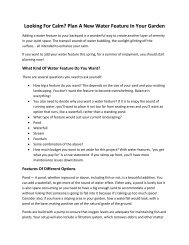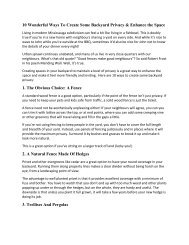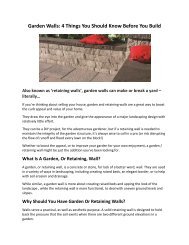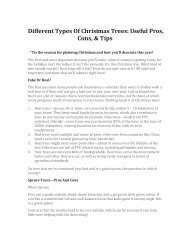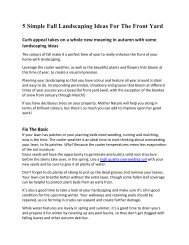33 Awesome Tips for Planting, Growing and Harvesting Tomatoes
Tomatoes are used almost in everything like salads, soups and making vegetables and more. Here are some tips to grow tomatoes in your own backyard garden. http://www.toemar.ca/33-awesome-tips-for-planting-growing-and-harvesting-tomatoes/
Tomatoes are used almost in everything like salads, soups and making vegetables and more. Here are some tips to grow tomatoes in your own backyard garden. http://www.toemar.ca/33-awesome-tips-for-planting-growing-and-harvesting-tomatoes/
You also want an ePaper? Increase the reach of your titles
YUMPU automatically turns print PDFs into web optimized ePapers that Google loves.
As an added bonus, when you boil your eggs, don’t throw away the water as it is full of calcium<br />
from the egg shells. Let the water cool off <strong>and</strong> water your tomato plants with it.<br />
10. Break the Disease Cycle<br />
To get rid of disease-causing organisms <strong>and</strong> stop the cycle, place your tomatoes on a 3-year<br />
rotation schedule with unrelated crops. Unrelated crops such as corn, beans, or lettuce will break<br />
the disease cycle.<br />
Make sure you don’t plant members of the tomato family which includes peppers, eggplants <strong>and</strong><br />
potatoes.<br />
In addition, get rid of diseased plants instead of composting them. Either throw them away or<br />
burn the diseased plants <strong>and</strong> any other garden debris like mulch or weeds that were in contact<br />
with the diseased plants.<br />
<strong>Growing</strong> <strong>Tomatoes</strong><br />
11. “A Little Vinegar With My Soil Please”<br />
Tomato plants like soil that has a pH between 5.5 – 6.8 so they are considered to be acid loving<br />
plants.<br />
Acidic soils have iron in a soluble <strong>for</strong>m which allow plants to take in the iron contained in the<br />
soil. <strong>Tomatoes</strong> have a high iron requirement to help it flourish <strong>and</strong> grow. Alkaline soils also have<br />
iron, but not in soluble <strong>for</strong>m <strong>and</strong> can’t be absorbed by the tomato plant.<br />
You can gauge whether your soil is acidic or alkaline by using two simple household items:<br />
vinegar <strong>and</strong> baking soda.<br />
Put a couple spoonfuls of soil into two separate containers. In one container, add some vinegar.<br />
If it fizzles, it means that your soil is alkaline <strong>and</strong> you are done. If it doesn’t fizzle, add water to<br />
other container with soil so it becomes wet <strong>and</strong> muddy. Add some backing soda to it <strong>and</strong> if it<br />
fizzles, it means your soil is acidic. If neither sample fizzles, then your soil probably has a<br />
neutral pH of 7.<br />
For other ways to determine soil pH, check out these tests.<br />
12. Stake Them High<br />
keeping disease away from tomato plants is always an ongoing issue, but manageable. One way<br />
is to use 6-foot stakes (what is showing above ground) or a trellis system <strong>for</strong> indeterminate<br />
tomatoes.<br />
By keeping the ripe fruit off the ground, it is less susceptible to disease <strong>and</strong> it is easier to harvest.




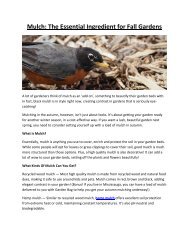

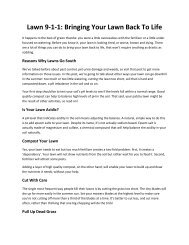

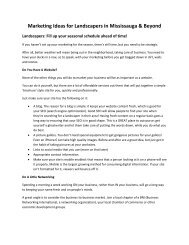
![What’s Hot In Backyard Design in 2018 [6 Tips to an Amazing Yard]](https://img.yumpu.com/60436469/1/190x245/whats-hot-in-backyard-design-in-2018-6-tips-to-an-amazing-yard.jpg?quality=85)
